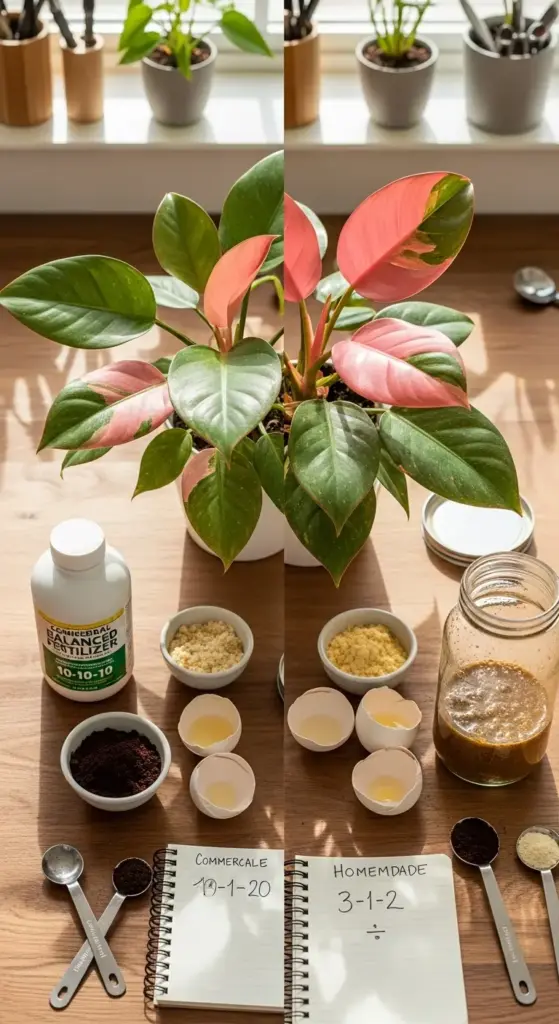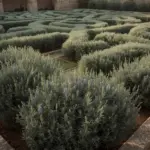3. The Fertilizer Formula Plant Collectors Swear By

I’m about to share the fertilizer secret that took me three years and way too many failed experiments to figure out. Most plant stores will never tell you this because they make more money selling you the wrong stuff.
My Pink Princess was stuck producing boring green leaves until I cracked this code. Now she’s a variegation machine.
The Magic NPK Ratio That Triggers Pink Production
Here’s what blew my mind: Pink Princess needs a 3-1-2 NPK ratio, not the balanced fertilizers everyone recommends. That means 3 parts nitrogen, 1 part phosphorus, and 2 parts potassium.
Standard houseplant fertilizers are usually 10-10-10 or 20-20-20. This balanced approach actually works against variegation because it gives the plant too much phosphorus.
I discovered this after joining a private plant collector group where someone shared their grandmother’s old greenhouse notes. She’d been growing variegated plants since the 1960s using this exact ratio.
The science makes sense once you understand it. Lower phosphorus levels create just enough nutrient stress to maintain variegation without harming the plant’s overall health.
Why Standard Fertilizers Are Sabotaging Your Plant
Miracle-Gro and similar balanced fertilizers push your Pink Princess to produce more chlorophyll, which means more green and less pink. It’s like feeding your plant performance enhancers for the wrong sport.
I used standard houseplant fertilizer for two years, wondering why my variegation kept fading. The plant was literally too well-fed to maintain its pink sectors.
High phosphorus levels signal the plant that it has abundant resources, so it doesn’t need to maintain energy-expensive variegated tissue. The result? Boring, solid green leaves.
Slow-release fertilizer pellets are even worse because they dump nutrients inconsistently, creating feast-or-famine cycles that stress variegated plants in all the wrong ways.
My Homemade Fertilizer Recipe That Actually Works
After months of experimenting, I developed this DIY fertilizer using common household ingredients. It costs about $3 to make and lasts six months.
Here’s my exact recipe: 1 tablespoon used coffee grounds (nitrogen), 1 teaspoon crushed eggshells (calcium), and 1/2 teaspoon banana peel powder (potassium). Mix with 1 gallon of water and let it steep for 24 hours.
The coffee grounds provide gentle, slow-release nitrogen without the harsh chemical burn of synthetic fertilizers. I collect grounds from my morning coffee and dry them on a baking sheet.
For the banana peel powder, I save peels in the freezer until I have about 10, then dehydrate them in my oven at 200°F for 2 hours. They crumble into perfect powder.
The Seasonal Feeding Schedule That Changed Everything
Spring and summer feeding is crucial – this is when your Pink Princess produces most of its new growth. I fertilize every 2 weeks from March through August using my homemade mixture.
During fall, I cut back to once monthly. Winter feeding is where most people mess up – I only fertilize once in December and once in February, if at all.
The plant’s metabolism slows dramatically in winter, so excess nutrients just sit in the soil and can cause root burn or fungal issues.
Here’s my exact schedule: March-August (bi-weekly), September-October (monthly), November-February (skip entirely or once maximum).
Recognizing the Signs of Nutrient Problems
Over-fertilization shows up as dark green, oversized leaves with minimal variegation. I learned this the hard way when I got excited and doubled my feeding schedule one summer.
The new growth came in huge and completely green. It took three months of backing off fertilizer before the pink started returning to new leaves.
Under-fertilization looks different – pale, small leaves with weak variegation that lacks the vibrant pink you want. The plant looks generally wimpy and sad.
Yellow leaf edges usually mean too much nitrogen, while brown, crispy edges typically indicate potassium deficiency or inconsistent watering (not always a fertilizer issue).
The Secret Ingredient Most People Miss
Calcium is the game-changer nobody talks about. Pink Princess needs extra calcium to maintain cell wall strength in variegated tissue, which is naturally weaker than green tissue.
I add crushed eggshells to my fertilizer mix, but you can also use bone meal or even antacid tablets (seriously – Tums work great dissolved in water).
Without adequate calcium, pink sectors become mushy and brown instead of staying crisp and vibrant. This was the missing piece in my fertilizer puzzle.
I noticed a huge difference in leaf quality within a month of adding calcium to my routine.
Liquid vs. Granular: What Actually Works
Liquid fertilizers give you way more control over nutrient delivery. Granular fertilizers are like giving your plant a giant meal once a month instead of regular snacks.
I dilute my homemade liquid fertilizer to quarter strength and use it more frequently. This mimics how plants receive nutrients in nature – small, consistent amounts rather than big dumps.
Granular fertilizers also tend to concentrate salts in the soil, which can burn roots over time. I learned this after killing a $200 Thai Constellation with overly strong granular fertilizer.
The Results That Made Me a Believer
After switching to my 3-1-2 homemade fertilizer, my Pink Princess started producing leaves with 50-70% pink variegation consistently. Before this, I was lucky to get 20% pink on new growth.
The difference was visible within just one month of changing my feeding routine. New leaves emerged with deeper, more vibrant pink coloration that actually lasted.
My plant also became more resilient overall. The stems got stronger, the leaves developed better texture, and growth became more predictable and vigorous.
Common Fertilizer Mistakes That Kill Variegation
Never fertilize a dry plant – this concentrates nutrients and can cause chemical burns. Always water first, then fertilize an hour later.
Fertilizing in winter is probably the biggest mistake I see. Your plant is basically hibernating and can’t process excess nutrients properly.
Another killer mistake: using fertilizer every time you water. Even gentle fertilizers become toxic with overuse. Stick to your schedule religiously.
And please, never use those fertilizer spikes. They create nutrient hot spots in the soil that can burn roots and create uneven growth patterns.
Ready to see your Pink Princess explode with new growth? Click “next” to discover the controversial pruning technique that forces your plant to produce more pink leaves – this method scared me at first, but the results are absolutely incredible!









GIPHY App Key not set. Please check settings